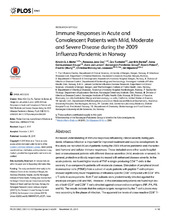| dc.contributor.author | Mohn, Kristin Greve-Isdahl | en_US |
| dc.contributor.author | Cox, Rebecca Jane | en_US |
| dc.contributor.author | Tunheim, Gro | en_US |
| dc.contributor.author | Berdal, Jan Erik | en_US |
| dc.contributor.author | Hauge, Anna G | en_US |
| dc.contributor.author | Jul-Larsen, Åsne | en_US |
| dc.contributor.author | Peters, Bjørn | en_US |
| dc.contributor.author | Oftung, Fredrik | en_US |
| dc.contributor.author | Jonassen, Christine M | en_US |
| dc.contributor.author | Mjaaland, Siri | en_US |
| dc.date.accessioned | 2016-04-05T12:22:17Z | |
| dc.date.available | 2016-04-05T12:22:17Z | |
| dc.date.issued | 2015-11-25 | |
| dc.Published | PLoS ONE 2015, 10(11):e0143281 | eng |
| dc.identifier.issn | 1932-6203 | |
| dc.identifier.uri | https://hdl.handle.net/1956/11849 | |
| dc.description.abstract | Increased understanding of immune responses influencing clinical severity during pandemic influenza infection is important for improved treatment and vaccine development. In this study we recruited 46 adult patients during the 2009 influenza pandemic and characterized humoral and cellular immune responses. Those included were either acute hospitalized or convalescent patients with different disease severities (mild, moderate or severe). In general, protective antibody responses increased with enhanced disease severity. In the acute patients, we found higher levels of TNF-α single-producing CD4+T-cells in the severely ill as compared to patients with moderate disease. Stimulation of peripheral blood mononuclear cells (PBMC) from a subset of acute patients with peptide T-cell epitopes showed significantly lower frequencies of influenza specific CD8+ compared with CD4+ IFN-γ T-cells in acute patients. Both T-cell subsets were predominantly directed against the envelope antigens (HA and NA). However, in the convalescent patients we found high levels of both CD4+ and CD8+ T-cells directed against conserved core antigens (NP, PA, PB, and M). The results indicate that the antigen targets recognized by the T-cell subsets may vary according to the phase of infection. The apparent low levels of cross-reactive CD8+ T-cells recognizing internal antigens in acute hospitalized patients suggest an important role for this T-cell subset in protective immunity against influenza. | en_US |
| dc.language.iso | eng | eng |
| dc.publisher | Plos | eng |
| dc.rights | Attribution CC BY | eng |
| dc.rights.uri | http://creativecommons.org/licenses/by/4.0/ | eng |
| dc.title | Immune Responses in Acute and Convalescent Patients with Mild, Moderate and Severe Disease during the 2009 Influenza Pandemic in Norway | en_US |
| dc.type | Peer reviewed | |
| dc.type | Journal article | |
| dc.date.updated | 2016-02-01T10:15:52Z | |
| dc.description.version | publishedVersion | en_US |
| dc.rights.holder | Copyright 2015 the authors | |
| dc.identifier.doi | https://doi.org/10.1371/journal.pone.0143281 | |
| dc.identifier.cristin | 1326179 | |
| dc.identifier.citation | PLoS ONE 2015, 10 (11), e0143281. | |

